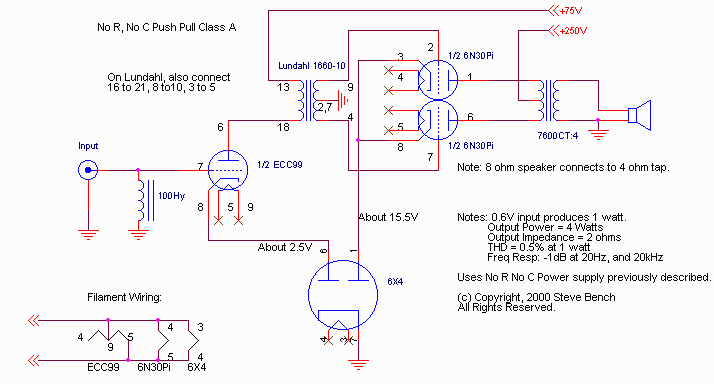
Continuing in the series of "no parts" amplifiers, this article describes a push pull version of a class of amplifiers using only tubes, inductors and transformers. (including the power supply). This amplifier uses either power supply previously described, requiring about 250 volts and 75 volts for the high voltage supplies, and 6.3VAC for the heaters. Since this is a push pull version, it is much more immune to power supply hum, so the "simple" version of the power supply (the left portion of the power supply amplifier shown here) produces a hum level that is about on par with DHT output stages. The more exotic powersupply (shown here) produces a perfectly quiet amplifier.
Specifications:
This amplifier is low distortion, low output impedance (for good damping), and reasonable sensitivity. It shares the same subtleties in its sonic performance as the SE amp, but the distortion signature contains 2nd and 3rd order components in approximately equal measure. Thus, some of the characteristics associated with SE operation are not present. Because of the biasing techniques used, second and third order products are about the same order of magnitude; unlike many push-pull amplifiers where odd harmonics clearly predominate. This amplifier operates Class A.
| Power Output | 4 watts at clip |
| Distortion | < 0.5% at 1 watt |
| Frequency Response | -1 dB at 20Hz and 20kHz. |
| Sensitivity | 0.6VRMS produces 1 watt |
| Output Impedance | < 2 ohms |
The Circuit:

Circuit Description:
This circuit is relatively similar to the SE version with a couple of twists. For PP class A operation, the cathode bias mechanism becomes actually easier, since the current is essentially constant with load: it merely changes from one output tube to the other during the conduction cycle. Thus, biasing the stage becomes merely a search for the right part to conduct properly. In this case, I wanted about 40-45mA current in the output stage (20-23mA per tube). Thus the search was to find something that would sink 40-45 mA at 15-16 volts. One plate of a 6X4 does this. The side benefit of this is that using a "rectifier" for the cathode load actually improves the performance, acting more like a "zener" than a resistor.
Also, I found that with very high plate load (effectively 15k plate to plate load impedance), the distortion produced was very low; almost dominated by the driver stage. Thus the sonic signature is more that of the driver stage than is common, producing SE like performance with the efficiency and power level of a PP stage. The 4 watts before clip comes in very handy in louder dynamic situations.
The ECC99 is a little uncommon. You *could* use a 5687 in this spot with similar results. The other half of the 6X4 biases this stage quite adequately with no sonic penalty. I also tried a 6AB4 (1/2 of a 12AT7) and it operated reasonably well in the circuit, but its higher plate resistance raised the low frequency cutoff more than I liked. Had higher sensitivity, of course.
With the original gas tube only regulated supply, there was a little hum still present; not nearly as much as the SE, but still audible. With the more exotic shunt regulator, this circuit is very quiet! (inaudible hum/noise with ear right at the speaker).
Interestingly, the sonics of this amp are more SE like than PP like. The harmonics produced are about equal between second and third, with fourth order way down and higher orders essentially non-existent. This amp sounds slightly louder for a given power level than previously described, but still softer for a given power than "usual" for a tube amp.
What's Next?
No R, No C, 5-10 watts, SE, DHT.
-Steve